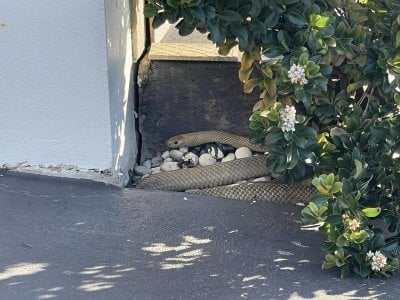Slithering concerns: New suburb faces chilling encounters with deadly discovery!
- Replies 22
Residents in a newly developed Australian suburb are on high alert after alarming reports surfaced about a potentially dangerous discovery in the area.
The unsettling find has sparked concern and raised questions among locals about their safety and the implications for the community.
As authorities investigate the situation, many are left anxious about what this could mean for their families and their neighbourhood.
In the heart of a newly developed Australian suburb, residents were met with a chilling surprise that sent shivers down their spines.
The tranquillity of Marsden Park, a suburb in Sydney's west, was shattered when the presence of one of the world's deadliest snakes turned their peaceful weekend into a scene of fear and caution.

As the sun warmed the earth and families began to enjoy the outdoors, the first sign of trouble came in the form of frantic phone calls to Chris Williams, a professional snake handler and owner of Urban Reptile Removal.
‘All the residents were quite new to the area. I got three phone calls in the space of a minute,’ Williams recounted.
The cause of the alarm? An eastern brown snake, a creature known for its lethal venom, was seen darting across backyards, sending the community into a state of high alert.
Marsden Park, once a stretch of farmland, has undergone a dramatic transformation since 2013.
The sprawling fields have been replaced by tightly packed townhouses, a change that has brought humans and wildlife into closer, and sometimes dangerous, proximity.
While seasoned Aussie farmers might shrug off an encounter with an eastern brown snake, the new residents of this suburb were understandably shaken.
‘The first caller was breathlessly panicking…the snake was pretty active and went from one yard to another before sheltering,’ Williams explained.
‘There were 20 pairs of eyes keeping a close watch on it before I got there.’
The tension was palpable as the community watched the snake seek refuge, awaiting the arrival of the expert.
The eastern brown snake is not to be underestimated.
‘Drop for drop, the eastern brown snake is the second most venomous snake in the world, and it’s the species that's responsible for most deaths in Australia,' Williams explained.
‘When I told that to the people in Marsden Park yesterday, you could see their faces went very pale. They didn't realise the significance or the dangers of an animal like that.’
Most snake bites occur when people, in a misguided attempt to be heroes, try to kill or capture the reptiles themselves.
Eastern browns, in particular, are known for their defensive aggression when confronted by potential threats, including humans.
However, it is this very behaviour that makes them somewhat easier for professionals like Williams to handle.
‘Because they’re easily agitated and will readily defend themselves, the Marsden Park snake just flung itself into the bag,’ he narrated, describing the capture.
However, the work of snake catchers like Williams is becoming increasingly complex.
In the suburbs of Australia, where development is rampant, the challenge is not just catching these reptiles but also finding suitable places to release them.
NSW laws protect all native reptiles, and there are strict regulations regarding how far they can be relocated due to their territorial nature.
While pythons can be moved to nearby bushland, the situation with eastern browns is more delicate, requiring a balance between animal welfare and human safety.
‘We’re still going through an enormous development phase out in Western Sydney, where we're not talking about one or two acres, we're seeing the absolute industrial scale redevelopment of hundreds of acres,’ Williams said.
‘So there's plenty of reptiles being displaced.’
The country is grappling with a housing crisis, and the controversial solution of clearing farmland and native forests for new developments is causing localised extinctions of once-common species, including marsupials, birds, and lizards.
Williams himself has observed the tragic consequences: ‘One thing I’m noticing a lot because I'm spending most of my time out in Western Sydney is the amount of kangaroos I'm seeing dead on the road,’ he said, a grim testament to the impact of urban sprawl.
‘I'm quite shocked. I would be seeing maybe 10 every day.’
In the southwest, where development is also rampant, endangered koalas are dying at alarming rates.
On Appin Road alone, 40 koalas have been killed in the last two years.
A parliamentary inquiry has grimly predicted that koalas could be extinct in NSW by 2050, and a government report from May warned that most threatened species in the state could vanish within a century.
There is optimism for species capable of adjusting to the destruction of their habitats.
Williams has highlighted these instances in his book Urban Reptiles, which features 50 different reptiles discovered in Australia's suburban areas.
‘I’m fascinated by the winners and losers of urbanisation,’ he said.
‘When I was releasing the eastern brown snake down a backroad, I saw an eastern bearded dragon dead on the road. They used to be super common across all of western Sydney.’
‘To see one dead on the road is devastating, but it’s also great because it means there’s still a colony there.’
‘On the other hand, eastern water dragons have adapted so well to living among us—they’re the stand-out champions. But the bearded dragons are the polar opposite,’ Williams added.
As concerns over the presence of eastern brown snakes continue to rise among residents in Marsden Park, Sydney, the timing of these sightings coincides with the onset of warmer weather.
With summer approaching, it’s crucial for the community to be aware of the potential increase in snake activity, as the heatwave can trigger early snake season alerts.
Being informed about safety measures and how to coexist with these reptiles is essential to ensure a secure environment for everyone.
 As we marvel at Australia's unique and diverse environment, it's crucial to remember the delicate balance between development and conservation. The shocking discovery in Marsden Park serves as a stark reminder of the consequences of encroaching on nature's territory. It's a call to action for all of us to consider the impact of our footprint on the world around us and to strive for a future where both humans and wildlife can coexist peacefully.
As we marvel at Australia's unique and diverse environment, it's crucial to remember the delicate balance between development and conservation. The shocking discovery in Marsden Park serves as a stark reminder of the consequences of encroaching on nature's territory. It's a call to action for all of us to consider the impact of our footprint on the world around us and to strive for a future where both humans and wildlife can coexist peacefully.
The unsettling find has sparked concern and raised questions among locals about their safety and the implications for the community.
As authorities investigate the situation, many are left anxious about what this could mean for their families and their neighbourhood.
In the heart of a newly developed Australian suburb, residents were met with a chilling surprise that sent shivers down their spines.
The tranquillity of Marsden Park, a suburb in Sydney's west, was shattered when the presence of one of the world's deadliest snakes turned their peaceful weekend into a scene of fear and caution.

Residents of a new housing development in Marsden Park, Sydney, have been alarmed by sightings of the deadly eastern brown snake. Credit: Facebook / Urban Reptile Removal
As the sun warmed the earth and families began to enjoy the outdoors, the first sign of trouble came in the form of frantic phone calls to Chris Williams, a professional snake handler and owner of Urban Reptile Removal.
‘All the residents were quite new to the area. I got three phone calls in the space of a minute,’ Williams recounted.
The cause of the alarm? An eastern brown snake, a creature known for its lethal venom, was seen darting across backyards, sending the community into a state of high alert.
Marsden Park, once a stretch of farmland, has undergone a dramatic transformation since 2013.
The sprawling fields have been replaced by tightly packed townhouses, a change that has brought humans and wildlife into closer, and sometimes dangerous, proximity.
While seasoned Aussie farmers might shrug off an encounter with an eastern brown snake, the new residents of this suburb were understandably shaken.
‘The first caller was breathlessly panicking…the snake was pretty active and went from one yard to another before sheltering,’ Williams explained.
‘There were 20 pairs of eyes keeping a close watch on it before I got there.’
The tension was palpable as the community watched the snake seek refuge, awaiting the arrival of the expert.
The eastern brown snake is not to be underestimated.
‘Drop for drop, the eastern brown snake is the second most venomous snake in the world, and it’s the species that's responsible for most deaths in Australia,' Williams explained.
‘When I told that to the people in Marsden Park yesterday, you could see their faces went very pale. They didn't realise the significance or the dangers of an animal like that.’
Most snake bites occur when people, in a misguided attempt to be heroes, try to kill or capture the reptiles themselves.
Eastern browns, in particular, are known for their defensive aggression when confronted by potential threats, including humans.
However, it is this very behaviour that makes them somewhat easier for professionals like Williams to handle.
‘Because they’re easily agitated and will readily defend themselves, the Marsden Park snake just flung itself into the bag,’ he narrated, describing the capture.
However, the work of snake catchers like Williams is becoming increasingly complex.
In the suburbs of Australia, where development is rampant, the challenge is not just catching these reptiles but also finding suitable places to release them.
NSW laws protect all native reptiles, and there are strict regulations regarding how far they can be relocated due to their territorial nature.
While pythons can be moved to nearby bushland, the situation with eastern browns is more delicate, requiring a balance between animal welfare and human safety.
‘We’re still going through an enormous development phase out in Western Sydney, where we're not talking about one or two acres, we're seeing the absolute industrial scale redevelopment of hundreds of acres,’ Williams said.
‘So there's plenty of reptiles being displaced.’
The country is grappling with a housing crisis, and the controversial solution of clearing farmland and native forests for new developments is causing localised extinctions of once-common species, including marsupials, birds, and lizards.
Williams himself has observed the tragic consequences: ‘One thing I’m noticing a lot because I'm spending most of my time out in Western Sydney is the amount of kangaroos I'm seeing dead on the road,’ he said, a grim testament to the impact of urban sprawl.
‘I'm quite shocked. I would be seeing maybe 10 every day.’
In the southwest, where development is also rampant, endangered koalas are dying at alarming rates.
On Appin Road alone, 40 koalas have been killed in the last two years.
A parliamentary inquiry has grimly predicted that koalas could be extinct in NSW by 2050, and a government report from May warned that most threatened species in the state could vanish within a century.
There is optimism for species capable of adjusting to the destruction of their habitats.
Williams has highlighted these instances in his book Urban Reptiles, which features 50 different reptiles discovered in Australia's suburban areas.
‘I’m fascinated by the winners and losers of urbanisation,’ he said.
‘When I was releasing the eastern brown snake down a backroad, I saw an eastern bearded dragon dead on the road. They used to be super common across all of western Sydney.’
‘To see one dead on the road is devastating, but it’s also great because it means there’s still a colony there.’
‘On the other hand, eastern water dragons have adapted so well to living among us—they’re the stand-out champions. But the bearded dragons are the polar opposite,’ Williams added.
As concerns over the presence of eastern brown snakes continue to rise among residents in Marsden Park, Sydney, the timing of these sightings coincides with the onset of warmer weather.
With summer approaching, it’s crucial for the community to be aware of the potential increase in snake activity, as the heatwave can trigger early snake season alerts.
Being informed about safety measures and how to coexist with these reptiles is essential to ensure a secure environment for everyone.
Key Takeaways
- Residents in a new housing development in Marsden Park, Sydney have been unsettled by sightings of the deadly eastern brown snake.
- Professional snake handler Chris Williams highlighted the danger and prevalence of these venomous snakes in newly urbanised areas.
- Urbanisation is resulting in displacement of reptiles and other wildlife, with localised extinctions of once-common species.
- There is hope for certain species that can adapt to urbanisation, as noted in Chris Williams' book, but the rapid development also poses serious threats to Australia's native wildlife.







